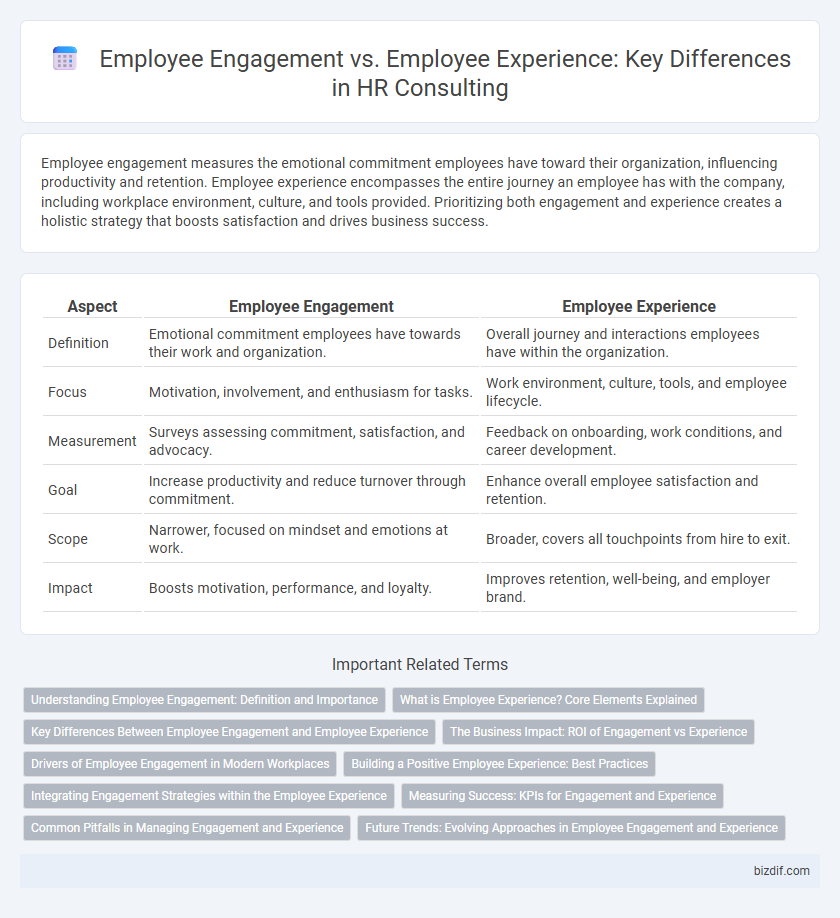Employee engagement measures the emotional commitment employees have toward their organization, influencing productivity and retention. Employee experience encompasses the entire journey an employee has with the company, including workplace environment, culture, and tools provided. Prioritizing both engagement and experience creates a holistic strategy that boosts satisfaction and drives business success.
Table of Comparison
| Aspect | Employee Engagement | Employee Experience |
|---|---|---|
| Definition | Emotional commitment employees have towards their work and organization. | Overall journey and interactions employees have within the organization. |
| Focus | Motivation, involvement, and enthusiasm for tasks. | Work environment, culture, tools, and employee lifecycle. |
| Measurement | Surveys assessing commitment, satisfaction, and advocacy. | Feedback on onboarding, work conditions, and career development. |
| Goal | Increase productivity and reduce turnover through commitment. | Enhance overall employee satisfaction and retention. |
| Scope | Narrower, focused on mindset and emotions at work. | Broader, covers all touchpoints from hire to exit. |
| Impact | Boosts motivation, performance, and loyalty. | Improves retention, well-being, and employer brand. |
Understanding Employee Engagement: Definition and Importance
Employee engagement refers to the emotional commitment and involvement an employee has toward their organization, significantly impacting productivity, retention, and overall company performance. It encompasses motivation, enthusiasm, and dedication, which drive employees to contribute beyond basic job requirements. Organizations with high employee engagement benefit from increased innovation, lower absenteeism, and stronger workplace culture, making engagement a critical metric for HR consulting strategies.
What is Employee Experience? Core Elements Explained
Employee Experience encompasses every interaction an employee has with their organization, from recruitment to exit, shaping their overall perception and satisfaction. Core elements include the work environment, organizational culture, technology and tools, leadership, and communication, all contributing to how employees feel and perform. Understanding and optimizing these factors can significantly enhance employee retention, productivity, and engagement levels.
Key Differences Between Employee Engagement and Employee Experience
Employee engagement measures an employee's emotional commitment and motivation towards their work and organization, while employee experience encompasses the entire journey an employee has with the company, including work environment, culture, tools, and interactions. Engagement is a specific outcome influenced by various factors within the broader employee experience, which includes onboarding, career development, recognition, and workplace conditions. Understanding the distinction helps HR consultants design targeted strategies to boost motivation through engagement initiatives and improve overall satisfaction through enhanced employee experience management.
The Business Impact: ROI of Engagement vs Experience
Employee engagement directly correlates with increased productivity, reduced turnover, and higher profitability, delivering measurable ROI through motivated and committed workforce behavior. Employee experience encompasses the holistic journey, influencing long-term talent retention and employer brand strength, which drives sustained financial performance and competitive advantage. Investing in both engagement and experience optimizes workforce effectiveness, maximizing overall business impact and revenue growth.
Drivers of Employee Engagement in Modern Workplaces
Employee engagement in modern workplaces is primarily driven by meaningful recognition, transparent communication, and opportunities for professional growth, which directly impact productivity and retention rates. Leveraging technology for real-time feedback and fostering a culture of inclusivity significantly enhance employee motivation and commitment. Strategic initiatives that align organizational values with individual roles create a more committed workforce, distinguishing engagement from the broader concept of employee experience.
Building a Positive Employee Experience: Best Practices
Building a positive employee experience involves creating a work environment that fosters trust, recognition, and meaningful opportunities for growth, which directly enhances employee engagement. Best practices include implementing transparent communication channels, personalized development programs, and regular feedback mechanisms to align organizational values with employee needs. Leveraging technology to streamline workflows and promote work-life balance also contributes significantly to sustaining high levels of employee satisfaction and retention.
Integrating Engagement Strategies within the Employee Experience
Integrating employee engagement strategies within the overall employee experience enhances workforce motivation and retention by aligning organizational goals with individual aspirations. Effective HR consulting leverages continuous feedback loops, personalized career development plans, and recognition programs to create a cohesive environment that fosters engagement. Data-driven insights and technology platforms play a critical role in tailoring these strategies, ensuring real-time responsiveness and measurable improvements in employee satisfaction and productivity.
Measuring Success: KPIs for Engagement and Experience
Key performance indicators (KPIs) for employee engagement include metrics such as employee satisfaction scores, turnover rates, and participation in company initiatives, which directly reflect workforce morale and involvement. Employee experience KPIs focus on measuring touchpoints across the employee lifecycle, including onboarding effectiveness, internal communication clarity, and accessibility of career development opportunities. Combining these metrics enables HR consultants to create data-driven strategies that enhance both engagement and overall employee experience for improved organizational performance.
Common Pitfalls in Managing Engagement and Experience
Common pitfalls in managing employee engagement and experience include overlooking the distinction between the two, leading to ineffective strategies that fail to address unique needs. Companies often rely solely on engagement surveys without implementing actionable changes, resulting in employee disengagement and decreased morale. Neglecting continuous feedback loops and personalized experiences also hampers sustained improvement in both engagement and overall employee satisfaction.
Future Trends: Evolving Approaches in Employee Engagement and Experience
Future trends in HR consulting emphasize the integration of advanced analytics and AI-driven insights to personalize employee engagement and experience strategies. Organizations prioritize continuous feedback loops and real-time sentiment analysis to enhance workforce well-being and foster a culture of inclusion and innovation. Embracing hybrid work models and digital collaboration tools further reshapes employee interactions, driving higher engagement and a more meaningful employee experience.
Employee Engagement vs Employee Experience Infographic

 bizdif.com
bizdif.com